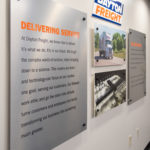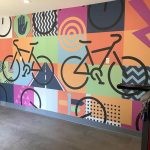
Wayfinding Signage at Colleges, Universities and High-schools
MARCH 1, 2021|When people arrive at your college, university or high-school, how do they know they’ve come to the right place? Your school likely has large signs at the entrances welcoming visitors, potential and current students, faculty and staff. But once an individual is on campus, how do they find their way around? They’ll need to get to the correct building for class, a meeting or an event.
In addition to school campus signage featuring your school’s name and logo, your school will benefit from directional signage that helps guide people along their way. Learn more about the benefits of wayfinding signage and how your school can make it work.
WHAT IS WAYFINDING SIGNAGE?
According to the Society of Experiential Graphic Design, wayfinding helps to guide people in a physical environment. It can also increase their understanding of a physical location and make their experience in a physical space better. Wayfinding signage typically falls into one or more category:
- Identification: An identification sign tells a person what a building is or lets them identify where they are. A simple example of a wayfinding sign in the identification category is a sign with a room number or name printed on it. A plaque at the entrance of a building with the name of the building on it is another example of an identification wayfinding sign.
- Information: Wayfinding signage also provides people with information. For example, a sign inside of a classroom building might state where the restrooms are located on each floor and what amenities those restrooms have, such as being wheelchair accessible or all-genders. An informational wayfinding sign can also tell people the opening hours of a campus building and can direct them to other locations when a building is closed.
- Direction: Directional signage tells people where to go. Directional signs can take many forms. They might involve arrows that point people one way or another. They can list the location of a room, such as being on the fifth floor. They can also be interactive. Floor decals that trace a path from point A to point B are examples of directional signage.
- Regulatory: In some cases, wayfinding signs allow a campus to meet regulatory requirements. An accessible restroom accessible should have the International Symbol of Accessibility on its sign. If a restroom is not accessible, a sign should direct people to the next closest accessible facility, per the Americans With Disabilities Act (ADA). Other examples of regulatory wayfinding signs include “no smoking” signs, “employees only” signs and “shoes and shirt required” signs.
![Uses of Outdoor Wayfinding Signage at Universities [list]](https://www.speedpro.com/wp-content/uploads/2020/11/02-Uses-of-Outdoor-Wayfinding-Signage-at-Universities.png)
USES OF OUTDOOR WAYFINDING SIGNAGE AT SCHOOLS
Outdoor directional signage performs multiple functions at a college, university or high-school. Here are some ways to use wayfinding signs outside.
- Welcome visitors: An outdoor sign placed at the entrance to your school’s campus lets people know that they have found the right place. It can also greet them and make them feel welcome on campus. Outdoor signage placed at the front of buildings welcomes visitors to those specific locations.
- Guide people to the right buildings: Outdoor wayfinding signage can direct people to specific locations. The signs can use arrows to help people know which way to turn as they navigate their way through a parking lot or along the paths or roads on campus. University campus signage can also provide more details, such a how far away a particular building is in feet, meters or minutes.
- Help people find their way: Wayfinding signage can also include maps that help people get their bearings and find multiple places once they are on campus. The maps can show people where they are and how far they can walk in 5 or 10 minutes. Maps can also give people advice on shortening their trip or inform them of their transportation options, such as taking the campus shuttle or using a bike share system.
- Share updates and information: Outdoor signage can also help keep visitors up-to-date on the goings-on at the school. For example, a digital sign at the campus entrance can display information about school closures. It can also provide updates about the school’s sports teams or faculty. If the school puts a new policy into place, such as requiring parking passes, displaying the information on an entrance sign lets people know what’s expected of them when they arrive on campus.
USES OF INDOOR WAYFINDING SIGNAGE AT SCHOOLS
Once a visitor, student or staff member finds the building they are looking for, they are likely to need additional guidance to figure out where to go within that building and what the rules are inside of it. Indoor directional signage can help people find their way and confirm that they are in the right spot. Some ways to use indoor wayfinding signs include:
- Identify rooms: Students need to find the right classroom on the first day of the semester, and visitors need to make sure they get to the right assembly room or office. Wayfinding signs can be as simple as plaques with room numbers printed on them, placed next to the doorway. If your school names classrooms and other areas instead of numbering them, the signs can feature the name of the room.
- Direct people to particular areas: Once a visitor or student gets into the building, they might find themselves wondering where the big assembly room is or how to find Lab B. Wayfinding signs on the wall can direct people to the right locations. The signs can use arrows to point people to where they need to go or list the floor numbers of each room. Directory signs, placed next to elevators or stairwells, can guide people to the right spots.
- Share rules and expectations: The buildings on your campus likely have rules and regulations, and those rules might change from building to building. For instance, a dormitory might be open 24/7 but have quiet hours overnight, during which time students are expected to keep it down. A lab building might be open to all during the day time but closed to the public between certain hours. Signage can convey the appropriate information to people so they know what to expect and what’s expected of them.
- Provide people with necessary information: Signs on the walls, next to doorways or near elevators and stairs can guide people by providing them with required information, such as details on what to do in the event of a fire, where they can find a restroom and who to call if they are locked out of a room.
SPEEDPRO CAN HELP YOU MAKE THE MOST OF CAMPUS WAYFINDING SIGNAGE
Make anyone who comes to your college, university, high-school campus feel welcome and confident by installing directional and wayfinding signage that clearly shows the way. When people can get where they need to go, they are likely to have a better impression of your school and are more likely to enroll, work there or tell their friends about their positive experience.
Also check out our schools and university page.
To get started creating wayfinding signs for your university or college, come visit us in Dayton today!









